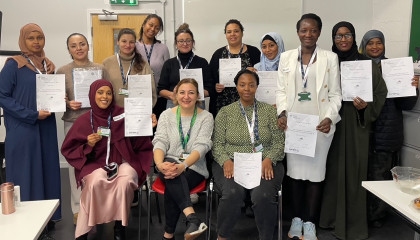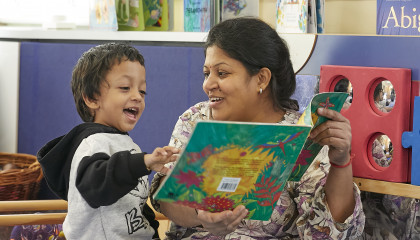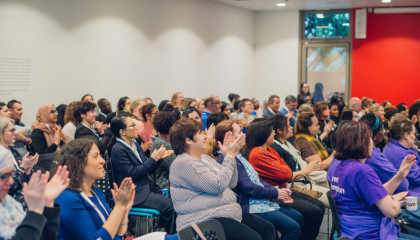You are here: How we can raise quality in the early years
The Family and Childcare Trust paper Putting quality at the heart of the early years, published today, is the third in a series of three papers looking at quality in the early years, following In for a pound, which looks at the relationship between staff wages and Ofsted grades in early years settings, and Driving high quality childcare: the role of local authorities. Our research has sought to show how national policy, early years funding and quality are inextricably linked. In this final paper, we have identified some less prominent but important ways of leveraging higher quality in the early years.
Gaps in children’s development open up in the early years but we know that these gaps can be minimised through high quality early education. Some early years settings are more effective than others in supporting children’s development and there are well-evidenced reasons why this may be the case, such as the ability of staff to understand and respond to each child’s needs and the capacity of integrated programmes to develop partnerships with parents. Indeed, there is a wealth of evidence about the characteristics of high quality early education.
With this evidence in mind, we have identified seven pragmatic opportunities to raise quality in the early years:
1. Supporting early years practitioners
Attention has rightly been given to the challenge of increasing the number of qualified graduates working in the early years. However, the needs of non-graduate early years practitioners who spend the most time with children have often been overlooked.
We set out proposals for a professional development framework to recognise expertise and support non-graduate early years practitioners. We also highlight the case for addressing the void in professional representation for early years professionals to strengthen the voice of practitioners in early years policy making.
2. Regulation and quality improvement
England benefits from integrated early years regulation through the Early Years Foundation Stage (EYFS) framework. However, the trend of rising Ofsted grades for early years settings has not been matched by a significant narrowing of the gap in developmental outcomes between the most and least disadvantaged children.
There is scope to better align the EYFS framework with the structural characteristics and practices that make a difference to children’s outcomes, such as the presence of highly qualified staff and a commitment to continuing quality improvement. Ofsted itself can also collect a richer range of metrics in the inspection process to provide settings with better information about changes they can make to raise quality.
3. Monitoring children’s development
Efforts to roll out an integrated health and development check for all children at age two have stalled and the future of the statutory EYFS profile assessment at age five has been put at risk by the chaotic introduction of a school-focused baseline assessment in reception class. The integrated review and the EYFS profile assessment are valuable tools which help monitor children’s development in the early years and provide the evidence needed to design high quality early years services: the Government should continue to support and promote both.
4. Integrated early years provision
Almost all children attend free early education but only some will ever enter a children’s centre. Integration of early years settings and early intervention services is therefore critical in identifying and meeting the needs of children and families. Statutory guidance should be revised to promote links between early years settings and children's centres to support outreach, target services effectively and ensure that help reaches the families who need it most.
5. Special educational needs and disabilities
The early years are the first opportunity to identify each child’s unique needs and ensure that they are supported to fulfil their potential. Unfortunately, children with SEND tend to fall behind before they reach school, in part because the quality of early years support is variable. To stop SEND expertise being overlooked in the early years, the Department for Education should invest in qualified early years area SENCOs.
6. Links between early years settings and families
One of the key differences between children from disadvantaged families who do well in school and those who do less well is a positive parental attitude to home learning. In addition to reviewing opportunities to promote home learning through the EYFS framework, the Department for Education should convene an expert working group to update existing best practice guidance for practitioners.
7. Enabling environments
The physical environment is an important influence on learning and development in early years settings but has been overlooked in policy making. For example, settings should be free of external noise pollution and must ensure good air quality. The challenge of rising childhood obesity means that it is critical that settings help to promote physical activity. To address gaps in evidence and ensure settings are fit for purpose, the Government should commission an audit and develop a strategy to shape the future early years estate.
The Government has an ambitious programme for the early years centred on rolling out 30 hours of free early education and childcare for three and four year olds and will invest an additional £1 billion of funding each year to support free provision by 2020. However, despite a commitment to a new early years workforce strategy in the near future, no funding has yet been committed to raising quality. It is unfortunately very likely that the new funding committed to free provision will be quickly swallowed up meeting cost pressures such as increases to the national minimum wage, rather than making the necessary quality improvements.
To support a proactive agenda for quality in the early years, we recommend a new £111 million ‘Early Excellence Fund’. The fund would support investment in graduate-led care for the most disadvantaged children, professional development and training for staff in small settings, quality networks to support integrated services and training for additional early years SENCOs.
Attitudes to quality in early years services reflect the kind of environment we choose to create for families with young children. Unfortunately, there has been a regression in expectations in recent years and quality has become an afterthought in funding decisions. When expectations drop, it is the children who are most likely to fall behind who lose out. Getting back on the right track is far from impossible but demands positive action from local and national policy makers.
More from our blog
Sign up to our newsletter
Get the latest news, research and resources from the Family and Childcare Trust.




